Peru Road Freight Transport Market Size
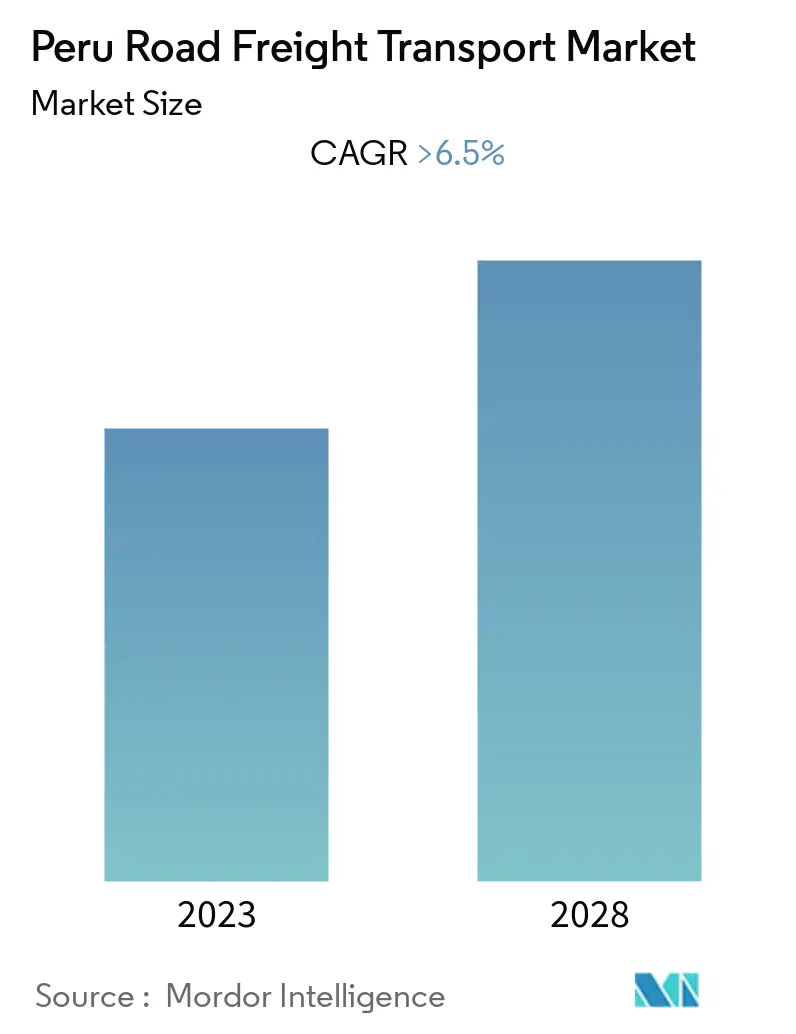
| Study Period | 2019 - 2028 |
| Base Year For Estimation | 2020 |
| Forecast Data Period | 2024 - 2028 |
| Historical Data Period | 2019 - 2019 |
| CAGR | > 6.50 % |
| Market Concentration | Low |
Major Players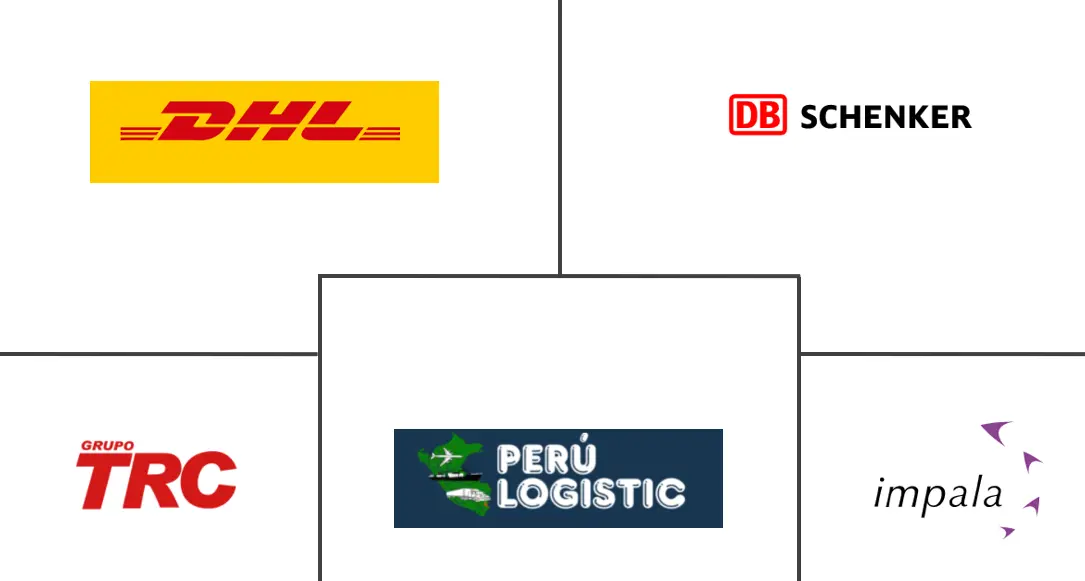
*Disclaimer: Major Players sorted in no particular order |
Need a report that reflects how COVID-19 has impacted this market and its growth?
Peru Road Freight Transport Market Analysis
The Peruvian road freight transport market is expeted to grow at a CAGR of more than 6.5% during the forecast period. COVID-19 has lowered Peru's economic growth to -13.9 percent for 2020, external demand was badly harmed by the fall in GDP among Peru's trade partners, and domestic demand dropped as a result of reduced household spending and the suspension of investment projects. In addition to the loss in aggregate demand, the economy was hit by a large supply shock as a result of the industrial halt imposed by the rigorous lockdown, which lasted several months. Peru's transportation infrastructure confronts challenges in terms of connecting modes of transportation, because, in addition to physical shortcomings, road freight transport costs are high and time-consuming. To develop its infrastructure, the Government launched 31 projects totalling more than USD 14 billion, many of which are operated through Public-Private Partnerships (PPPs). In the same way, three projects totalling over 3,000 kilometres are being developed within the framework to support road freight transportation. The CAF (Development Bank of Latin America) approved two operations totalling USD 723 million in 2020 for the Republic of Peru to assist the government in combating the pandemic's effects and improving the subnational road infrastructure, this results in lowering the logistical costs to boost the country's competitiveness. The first stage of the Road Infrastructure Program for Regional Competitiveness was approved for USD 373.4 million, to improve and conserve 4,948 kilometres of road over 18 corridors.
Peru's road freight transport business is bolstered by the country's mining industry, manufacturing industry and agriculture industry. In mining, Peru is a global leader in the production of lead, copper, gold, and zinc, all of which are heavily exported. The most important mining resource in the country is gold. The Yanacocha and Pierina gold mines are the most important gold sources in Peru. In comparison to Peru's other gold reserves, they also generate the most revenue. Gold and copper deposits amount to millions of ounces in the country. The manufacturing industry accounts for 20% of the country's gross domestic product. Peru used to export the majority of its raw commodities. However, raw materials are now treated before being delivered to add value. Peru has experienced a rise in agricultural exports over the last two decades, driven by seasonal exports of high-value fresh fruits and vegetables to the northern hemisphere (mostly grapes, avocados, blueberries, and asparagus).
Peru Road Freight Transport Market Trends
This section covers the major market trends shaping the Peru Road Freight Transport Market according to our research experts:
Growth in Exports & Imports boosting Road Freight Transport:
Peru's imports and exports have created a strong foundation for the country's road freight transport to flourish. Because Peru has a long coastal line with several ports, trucking has become the primary mode of transport from ports to final destinations. Peru's top trading partners in 2020 are China (USD11 billion, or 28.3% of total exports), the United States (USD 6.2 billion, or 16.1%), Canada (USD 2.4 billion, or 6.2%), South Korea (USD 2.3 billion, or 5.8%), Japan (USD 1.7 billion, or 4.4 percent), the Netherlands (USD 1.4 billion, or 3.7 percent), and Switzerland (USD 1.4 billion, or 3.5 percent). In 2020, the Republic of Peru exported goods worth USD 38.8 billion around the globe. By value, 46.1 percent of Peruvian exports went to Asian countries, while 23.4 percent went to North American buyers. Peru exported 17.6% of its commodities to Europe, with 11.4 percent to Latin America (excluding Mexico but includes the Caribbean). The only top importers who raised their imports from Peru from 2019 to 2020 were the United States (up 12.4%), South Korea (up 3.3%), and the Netherlands (up 1.3%).
Peru is fast overtaking Chile as the leading supplier of fresh fruits and vegetables in South America. Peruvian exports have soared. They have increased from less than a million tonnes in 2011 to 2.25 million tonnes in 2020. This is up to a 20% increase over the previous year. Avocados, grapes, onions, mangos, and bananas are at the top of the list. Peru's fruit and vegetable exports to the United States will account for 36% of total exports in 2020. Peru's second-largest buyer in the Netherlands. Peruvian grapes are the country's most popular export. In 2020, their exports increased significantly (+19 percent). The Netherlands is by far the most popular destination for avocados from Peru. These exports to the Netherlands increased by 30%. The Netherlands also buys the majority of Peruvian mangoes.
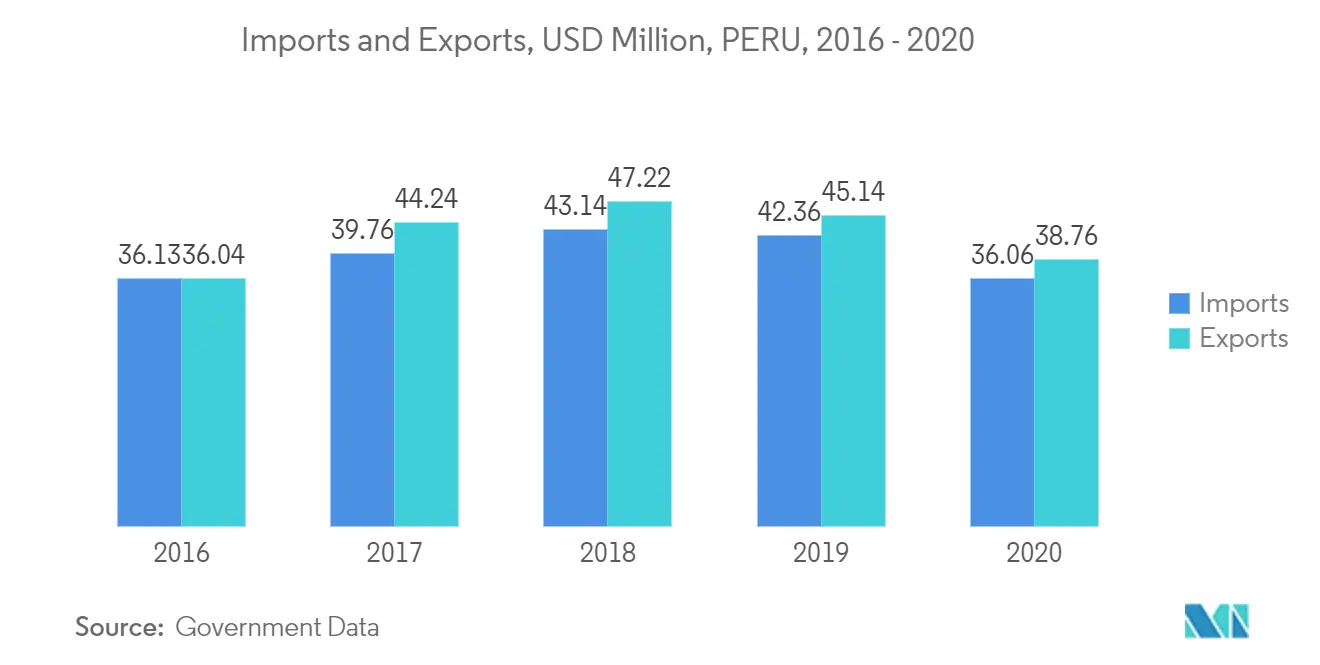
Cross Border Trade with Rest of South America:
Latin American and Caribbean (LAC) countries have been cutting import tariffs for at least three decades, both unilaterally and reciprocally, through participation in regional integration agreements and free trade agreements with extra-regional partners. Commerce facilitation and the digitization of border operations have become increasingly critical variables in attaining competitiveness in global trade as the relative relevance of tariffs has declined. The cross-border trade has generated a vast market for the road freight transport business in Peru, and this has been a key driver for developing the road freight industry. Peru is responsible for 5.1% of Bolivia´s total exports (of which soybean meal represents more than 50%) and Bolivia for 1.6% of Peru´s total exports (with a more diversified portfolio, led by iron and chemical-based products).
Brazil is Peru's third-largest trading partner. In the exports of transportation (USD 581 million), machines (USD 374 million), and metals (USD 322 Million) Brazil had strong net trade with Peru in 2019. Peru has a substantial net trade deficit with Brazil in Mineral Products (USD 903 million), Metals (USD 239 million), and Textiles (USD 62.2 Million). The primary products exported to Peru from Brazil, in 2019, were passenger automobile vehicles, which brought in USD 169 million in income. The second place goes to automotive vehicles for goods transport and special purposes, which account for 7.3 percent of all exports to Peru and generate USD 162 million in income. The major products of Brazil imports from Peru in 2020 are copper (26%) and other ores and base metal concentrates (16%), copper ores and concentrates (7.4%), crude fertilizers (7.4%), fuel oils from petroleum or bituminous minerals (5.6%), coal, even powdered but not agglomerated (4.4%), plastic sheets, sheets, films, strips, and sheets (3.3 percent).
The commercial exchange between Peru and Chile totaled USD 2.13 million in 2020, with minerals being the most commercialized product in the Chilean market. However, trade between the two countries decreased by 18.8% in comparison to 2019, when it totaled USD 2.62 million, owing to the pandemic-induced crisis.
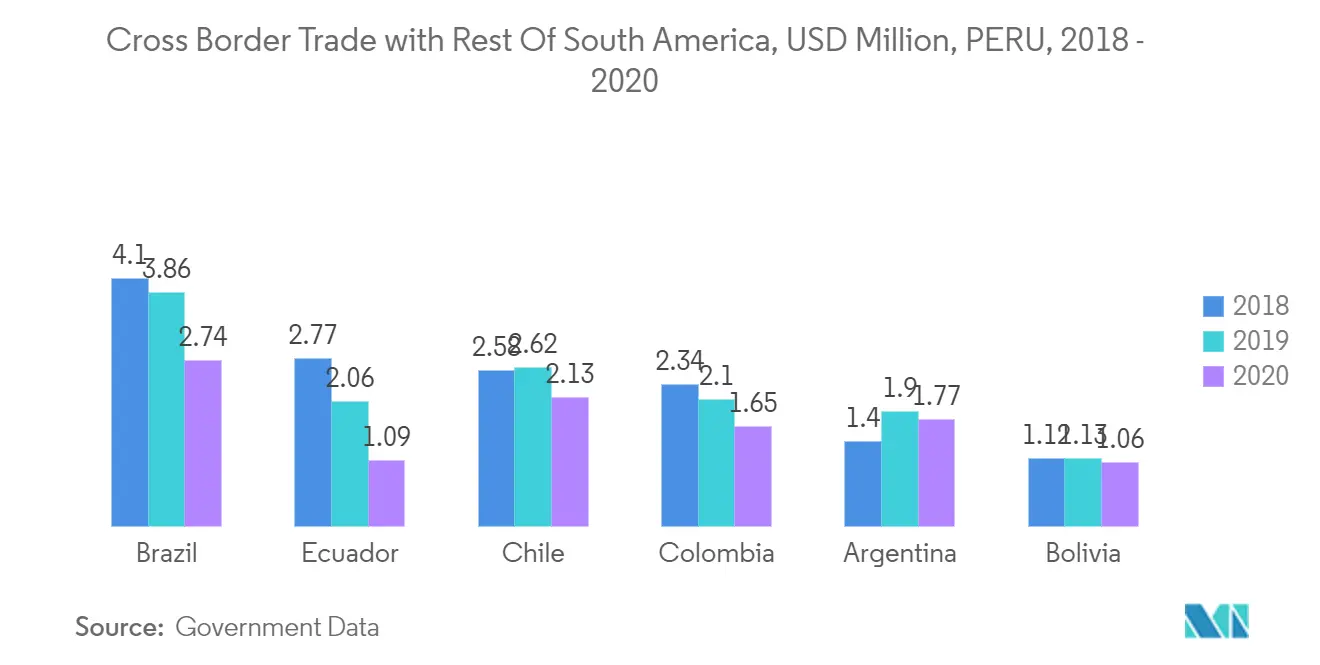
Peru Road Freight Transport Industry Overview
The Road Freight Market landscape of Peru is fragmented in nature with a mix of global and local players, this makes the sector highly competitive. Some of the strong players of the country include DHL, DB Schenker Logistics, TRC Group, Peru Logistic SAC, Impala Terminals. Imports and exports have been halted, and most port operations have been restricted, negatively impacting the country's road freight transportation economy. Even though Peru's infrastructure is inadequate, posing a barrier to the expansion of the road freight industry, different infrastructure initiatives for the industry's expansion began in 2020. The majority of competitors in the industry are expanding to take advantage of the global supply of fresh vegetables and fruits.
Peru Road Freight Transport Market Leaders
DHL
DB Schenker Logistics
TRC Group
Peru Logistic SAC
Impala Terminals
*Disclaimer: Major Players sorted in no particular order
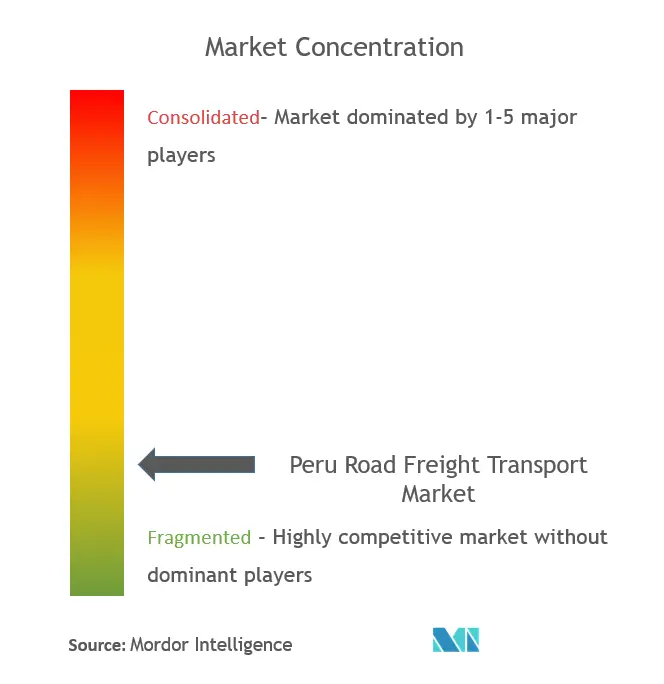
Peru Road Freight Transport Market News
Aug 2021: Kerry Logistics has opened a new office in Peru as it expands in the Latin America region. The company offers domestic transportation across the country along with air and ocean freight services, customs clearance in the country. The tragest markets of the company include mining industry, apparel, automotive, high-tech, as well as pharmaceutical.
Peru Road Freight Transport Market Report - Table of Contents
1. INTRODUCTION
1.1 Study Assumptions
1.2 Scope of the Study
2. RESEARCH METHODOLOGY
2.1 Analysis Methodology
2.2 Research Phases
3. EXECUTIVE SUMMARY
4. MARKET INSIGHTS
4.1 Current Market Scenario
4.2 Technological Trends
4.3 Government Regulations
4.4 Value Chain / Supply Chain Analysis
4.5 Overview of Logsitics and Warehousing Market
4.6 Brief on Freight Rates
4.7 Spotlight on 3PL Market
4.8 Demand and Supply Analysis
4.9 E-Commerce Logistics Market
4.10 Impact of COVID-19
5. MARKET DYNAMICS
5.1 Drivers
5.2 Restraints
5.3 Opportunities
5.4 Industry Attractiveness - Porter's Five Forces Analysis
5.4.1 Bargaining Power of Suppliers
5.4.2 Bargaining Power of Consumers
5.4.3 Threat of New Entrants
5.4.4 Threat of Substitutes
5.4.5 Intensity of Competitive Rivalry
6. MARKET SEGMENTATION
6.1 By Destination
6.1.1 Domestic
6.1.2 International
6.2 By End User
6.2.1 Manufacturing (Including Automotive)
6.2.2 Oil and Gas, Mining, and Quarrying
6.2.3 Agriculture, Fishing, and Forestry
6.2.4 Construction
6.2.5 Pharmaceutical and Healthcare
6.2.6 Other End Users
7. COMPETITIVE LANDSCAPE
7.1 Overview (Market Concenttration and Major Players)
7.2 Company Profiles
7.2.1 DHL
7.2.2 DB Schenker Logistics
7.2.3 TRC Group
7.2.4 Peru Logistic SAC
7.2.5 Impala Terminals
7.2.6 Scharff Logístics
7.2.7 SAVAR CORPORACIÓN LOGISTICA
7.2.8 Gold Cargo
7.2.9 ANDINA FREIGHT - We Think Big
7.2.10 Marvisur Express*
- *List Not Exhaustive
8. MARKET OPPORTUNITIES AND FUTURE TRENDS
9. APPENDIX
9.1 Macroeconomic Indicators (GDP Distribution by Activity, Contribution of Transport and Storage Sector to economy)
9.2 Insights on Capital Flows (investments in Transport and Storage Sector)
9.3 E-commerce and Consumer Spending-related Statistics
9.4 External Trade Statistics - Import & Export
Peru Road Freight Transport Industry Segmentation
The transportation of goods/products via roadways is referred to as road freight transport. It is also one of the world's most traditional kinds of logistics, as well as the most widely used mode of transportation worldwide. If and when needed, road freight is utilized in combination with air and sea freight modes to provide door-to-door delivery. The Peru Road Freight Market is segmented by destination (Domestic, International), By End User (Manufacturing (Including Automotive), Oil and Gas, Mining, and Quarrying, Agriculture, Fishing, and Forestry, Construction, Pharmaceutical and Healthcare, Other End Users). A comprehensive background analysis of the Peru Road Freight Market covering the current market trends, restraints, technological updates, and detailed information on various segments and competitive landscape of the industry. The impact of COVID-19 has also been incorporated and considered during the study.
| By Destination | |
| Domestic | |
| International |
| By End User | |
| Manufacturing (Including Automotive) | |
| Oil and Gas, Mining, and Quarrying | |
| Agriculture, Fishing, and Forestry | |
| Construction | |
| Pharmaceutical and Healthcare | |
| Other End Users |
Peru Road Freight Transport Market Research FAQs
What is the current Peru Road Freight Transport Market size?
The Peru Road Freight Transport Market is projected to register a CAGR of greater than 6.5% during the forecast period (2023-2028).
Who are the key players in Peru Road Freight Transport Market?
DHL, DB Schenker Logistics, TRC Group, Peru Logistic SAC and Impala Terminals are the major companies operating in the Peru Road Freight Transport Market.
Peru Road Freight Transport Industry Report
Statistics for the 2023 Peru Road Freight Transport market share, size and revenue growth rate, created by Mordor Intelligence™ Industry Reports. Peru Road Freight Transport analysis includes a market forecast outlook to 2028 and historical overview. Get a sample of this industry analysis as a free report PDF download.
